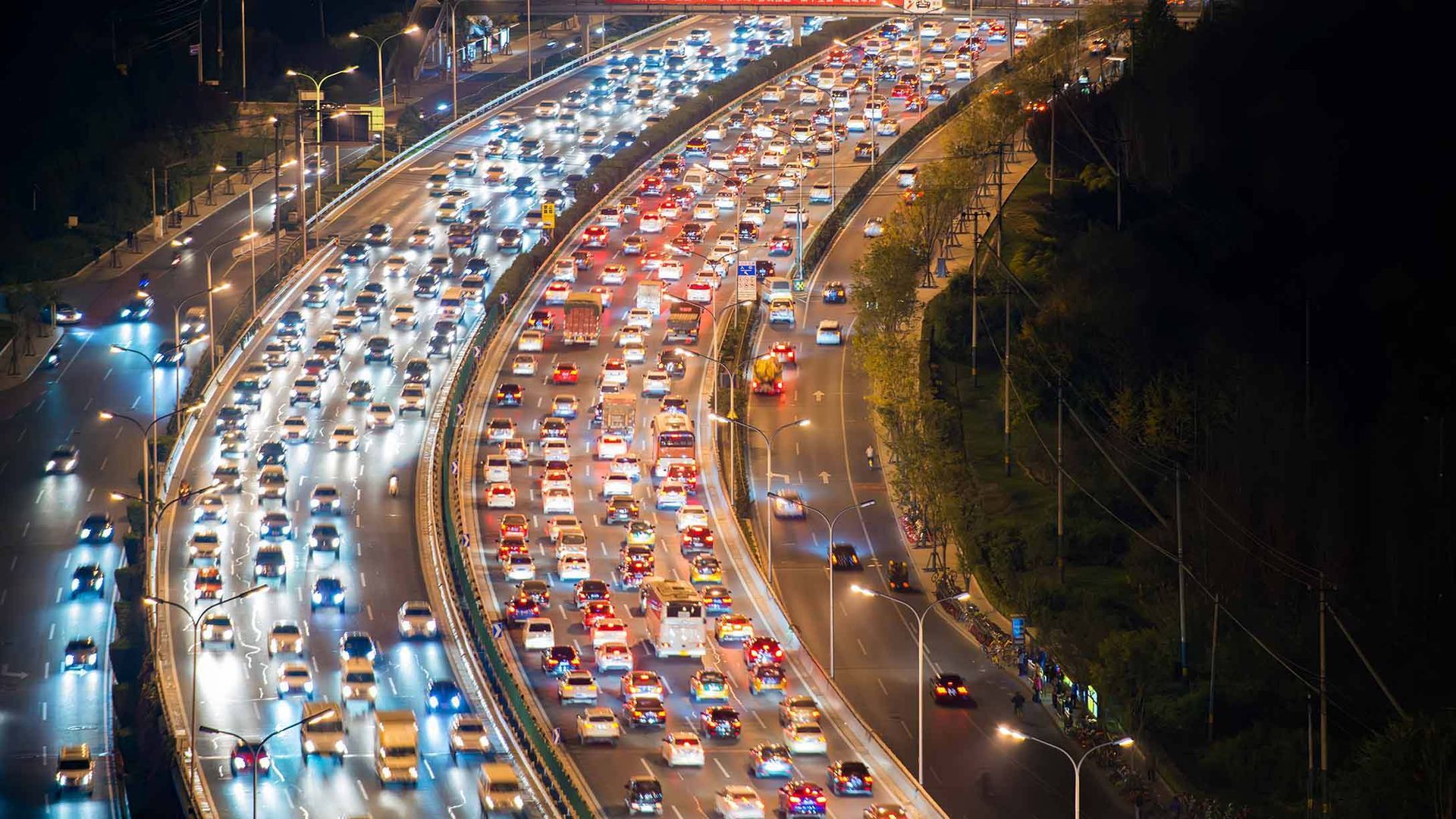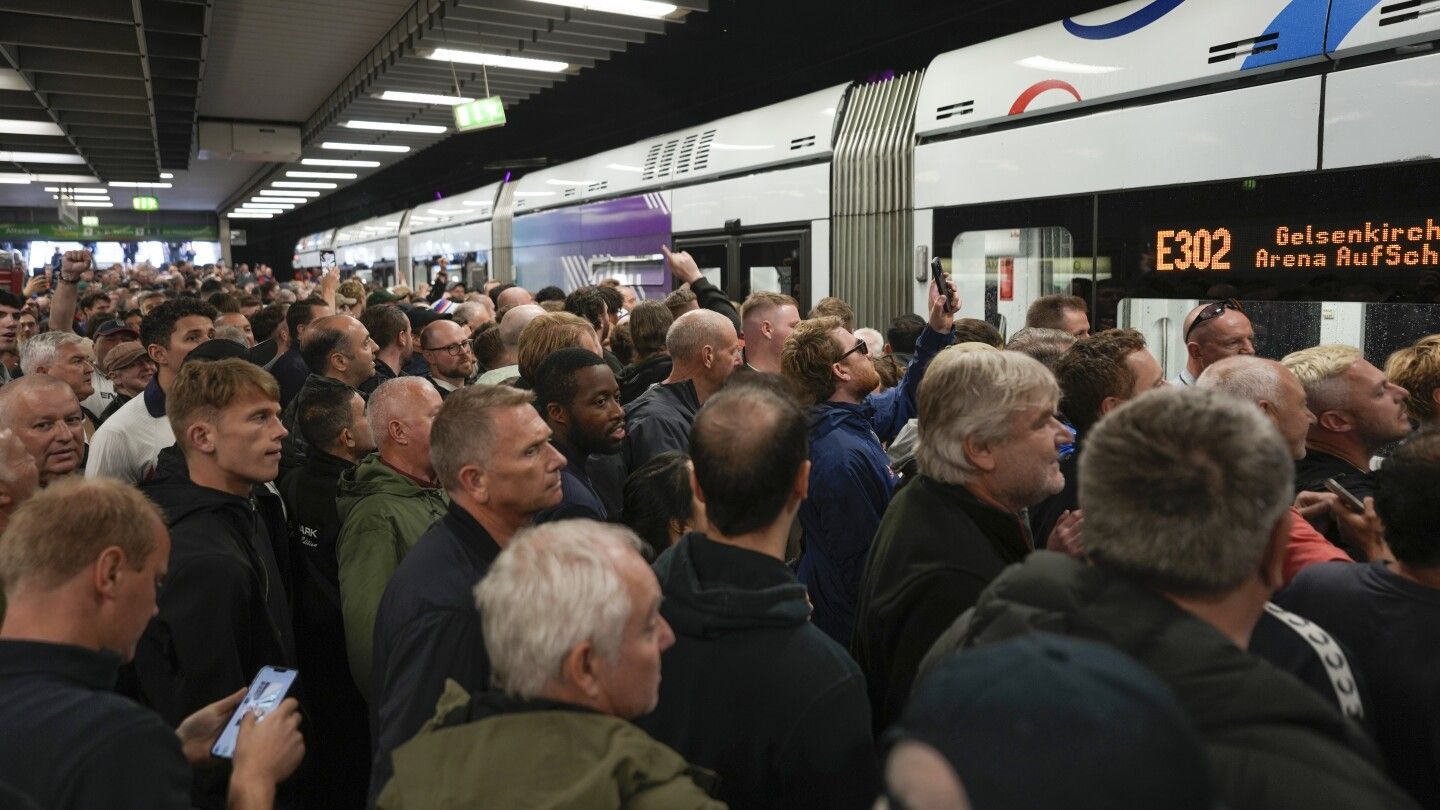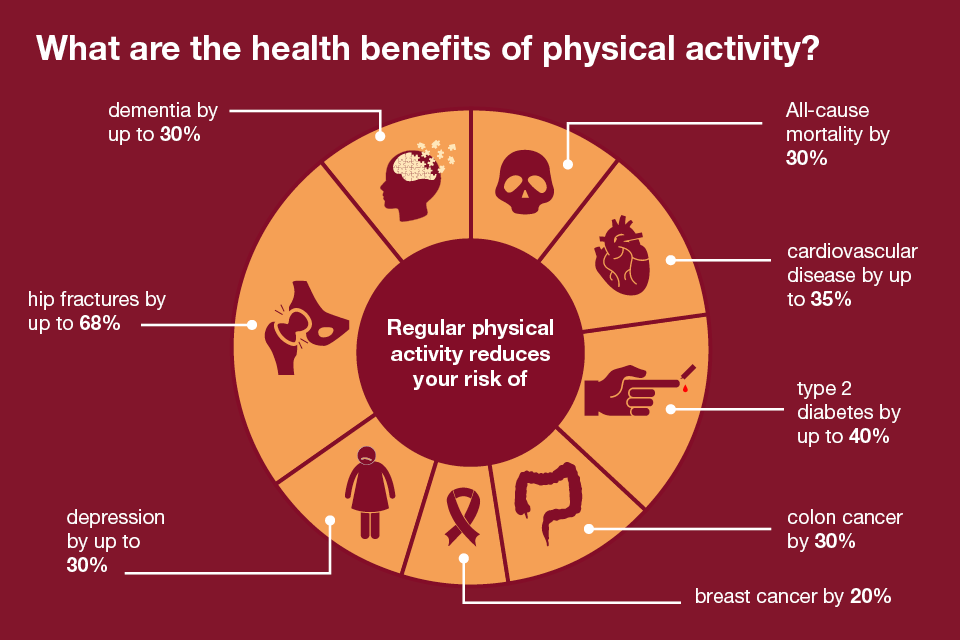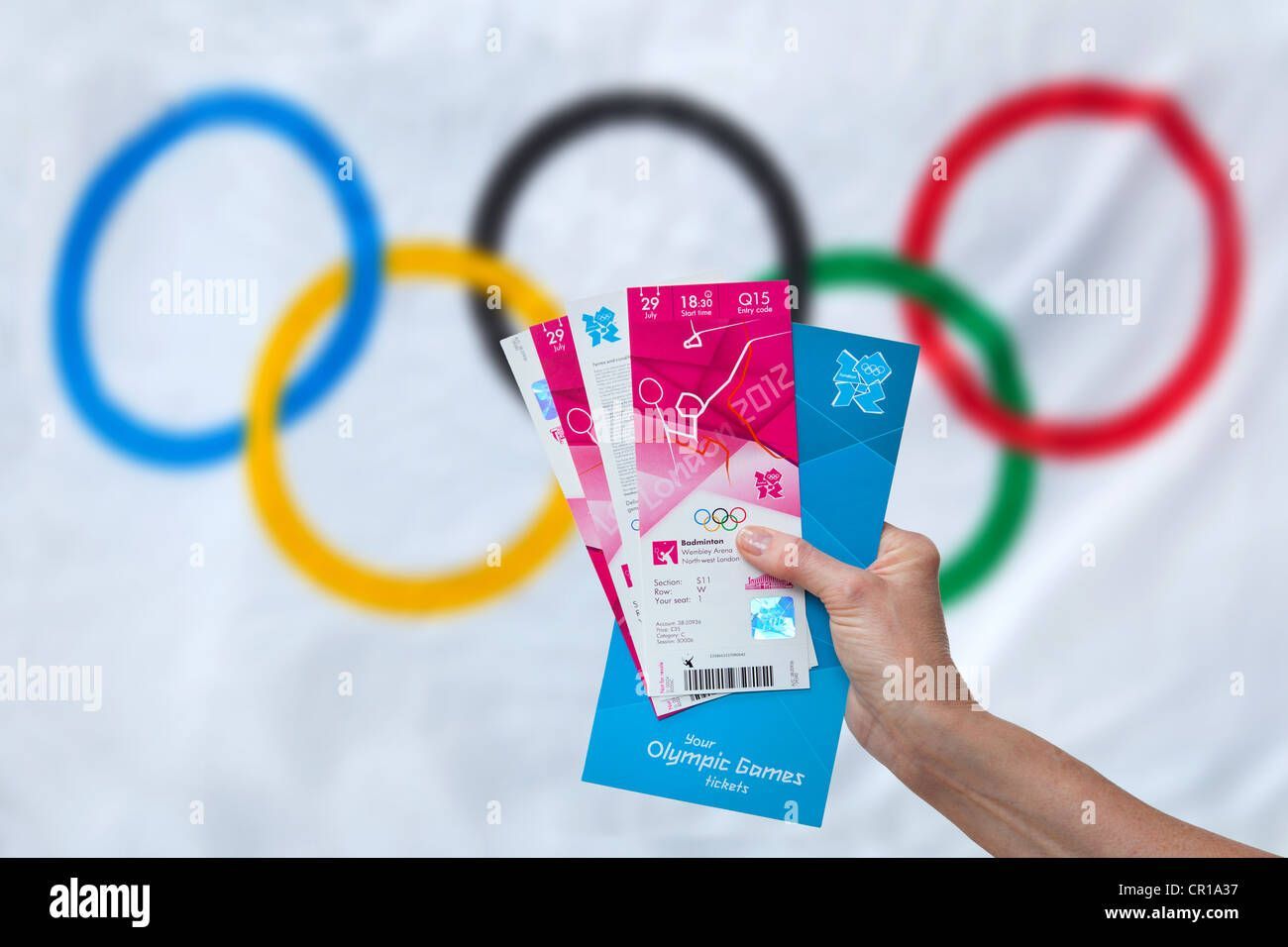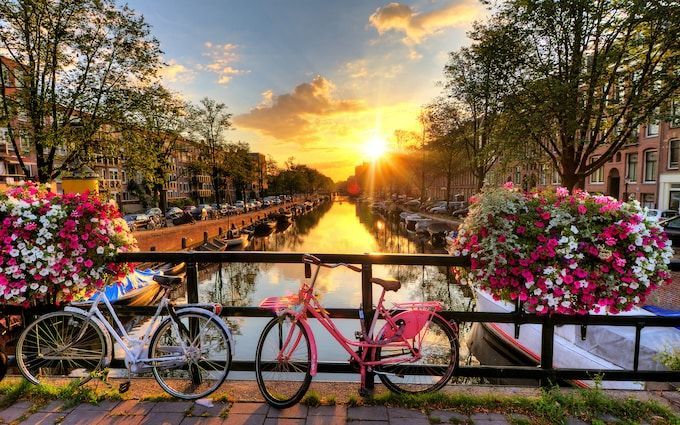Driving sustainable travel behaviour change through the power of marketing and communications for audiences and spectators
Marketing and communication campaigns are pivotal in shaping travel behaviours and ensuring the success of sustainable transport initiatives. For infrastructure and services to truly thrive, they must be paired with clear, engaging communications. By increasing the visibility and attractiveness of sustainable travel options and engaging audiences, targeted campaigns can drive measurable outcomes, reduce congestion, and enhance user experiences. This blog highlights some of the powerful campaigns which have changed behaviour of their audiences across the globe and highlights some key takeaways that our STRIVE consultancy service utilises to help venues and events replicate and expand on their success, whether the goal is to influence spectator travel or the travel behaviours of the local community going about their everyday lives.
Impactful event-based case studies showing how marketing drives change in transport behaviour
London 2012 Olympic Games saw 35% of Londoners change their travel behaviour
To help ensure the success of the London 2012 Olympic Games research determined that not only would spectators need to fully understand the best way to navigate London’s transport system but that 30% of Londoners would also need to change their usual travel behaviour for the City’s transport system to be able to cope with the c10million ticket-holders expected to attend the event.
As a result, one of the most impactful travel demand management campaigns in history was conceived and launched, significantly reducing congestion and ensuring smooth travel for spectators. In the Round co-founders, who were at the time part of the senior leadership team for TDM for the Olympics, spearheaded the marketing, communications and business engagement activity required to encourage the adoption of new travel behaviours by visitors and residents alike. The Olympics saw 101 million journeys on the London Underground (a 25% increase from the same period the year before), over 2.4 million trips on the Javelin train, 360,000 park-and-ride trips to the Eton Dorney rowing venue, and 86% of spectators at the Olympic Stadium rated their journey home as "extremely good." Efforts extended beyond just the spectators, targeting the general public (background demand) with a campaign to encourage 30% of regular commuters to modify their travel routines, helping free up space for event attendees. The campaign exceeded expectations, with 35% of background demand adapting their behaviour during the Games. Through extensive marketing communications, the messages of "re-route, re-time, re-mode, and reduce" were widely promoted. More information on this campaign can be found here.
Picture source: Transport for London
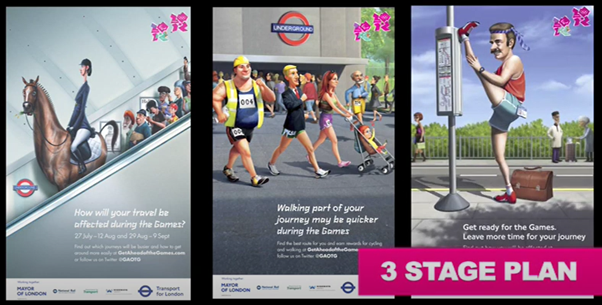
A multi-channel campaign for successful travel behaviour change at the Gold Coast 2018 Commonwealth Games
In the Round worked with State Government, the event organising committee and local authorities to ensure that the marketing and communications campaign for the Gold Coast 2018 Commonwealth Games in Australia, used an extensive, multi-channel approach to prepare residents and visitors for the anticipated travel impacts. In the crucial lead-up phase, the campaign, branded “Get Set for the Games”, combined digital and social media with transit and outdoor advertising, in-transit posters, radio and cinema ads, and interactive travel information to reach a broad audience across the Gold Coast and surrounding areas. With tactics like light rail and cab wraps, billboards, airport and hotel signage, station announcements, and corflutes at transit hubs, the campaign achieved exceptional visibility. By the time of the Games, the campaign’s recall rate was high, with 86% of Gold Coast residents recognising the "Get Set for the Games" branding and 77% recalling television ads, which proved particularly effective. The campaign’s messaging, emphasising “plan ahead” and “use alternative modes of transport,” resonated with residents, prompting 66% to take some action, whether by visiting the website, discussing travel plans with others, or reconsidering non-essential trips. Overall, the campaign’s success demonstrated how a strategically coordinated communications effort can achieve wide reach and meaningful behaviour change in the context of a large event.
Picture source: Gold Coast 2018 Commonwealth Games

Glasgow 2014 Commonwealth Games reducing game-time disruption through comms
In 2014, In the Round contributed to the TDM programme for the Glasgow Commonwealth Games in the UK, using targeted marketing and communication to ease congestion and improve transit experiences for spectators, businesses, and the public. In the Round’s consultants also led the travel advice to spectators work area, galvanising multiple local agencies to ensure that ticket holders were advised of the best travel options for each venue in a timely, consistent and integrated manned. This included across web and social media content, targeted e-mails on specific elements such as park and ride and promotion of Traveline Scotland’s preferred journey planner for the event.
With high campaign awareness (85%), about 25% of travellers adapted their routines by choosing alternate routes, switching to trains, adjusting travel times, or incorporating walking. Tailored support for businesses ensured 83% could operate smoothly throughout the event. While 3% of participants committed to lasting behaviour changes, the programme successfully minimised disruptions during the Games and demonstrated the effectiveness of strategic communication in encouraging sustainable travel. As Glasgow prepares to host the Games again in 2026, it will be fascinating to see if similar approaches build on the legacy of 2014.
UEFA’s Champions League Final (2017) achieved 18% decrease in traffic due to transport marketing communications plan
In 2017 for the UEFA Champions League Final in Cardiff, UK, In the Round demonstrated how strategic marketing and communication can drive travel behaviour change, even in a high-demand event environment. A comprehensive, integrated and multi-agency communication strategy ensured a "single source of truth" across all information channels, including websites, press releases, advertising, direct marketing, community engagement, social media, digital platforms, transport channels, and variable message signs.
This cohesive approach led to record-breaking attendance, with 300,000 people in Cardiff on the day, yet still managed to yield positive travel behaviour shifts. Locals notably adjusted their habits, resulting in an 18% decrease in traffic compared to the same Saturday in the previous year. Supporting the sustainable travel initiative, the dedicated travel guide app saw over 10,000 downloads, and the event's Twitter page garnered 3.1 million impressions, underscoring the campaign’s wide reach and effectiveness in promoting sustainable transport.
Picture source: UEFA Champions League Final 2017
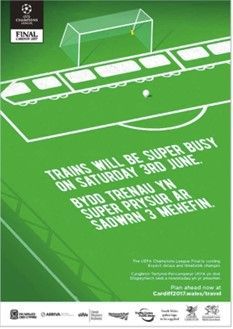
Eisteddfod Festival – transforming travel for 150,000 attendees
The 2024 edition of the annual National Eisteddfod of Wales took place in a more urban setting than usual. Pontypridd, a small town in South Wales (UK), hosted what was traditionally a rural affair bringing 150,000 additional visitors over the 8-day period of the event to an already busy area in August. In the Round galvanised local agencies to create a coordinated transport marketing communications plan for the event aimed at encouraging ticket holders and the local community alike to adopt more sustainable travel behaviours to help mitigate usual peak hour road congestion. Following the establishment of a multi-agency communications group with the event organisers, local authorities, transport agencies, business representatives and others, sustainable travel options were communicated consistently and supported by dedicated travel web pages, local radio and social media and direct targeted communications to event ticket holders via e-bulletin. The result? Over 100,000 attendees travelled by train, and park-and-ride was used en masse, resulting in no queues and highly positive social media feedback with some commentators observing that the local roads were even quieter than usual, yet the town and the event thrived.
Photo source: Transport for Wales

Impactful non-event-based case studies showing how marketing drives change in transport behaviour
In Malmö, Sweden, the bold “No Ridiculous Car Journeys” campaign encouraged residents to question the necessity of short car trips under 5 km. By using unconventional tactics like live billboards with cyclists on raised platforms and a contest that invited people to confess their “most ridiculous car trips,” Malmö sparked public conversation and engagement. This direct, relatable messaging, paired with humorous branding, successfully reduced car journeys from 52% to 34% of total trips between 2003 and 2018, while biking increased from 20% to 26%.
Picture source: Jens Lannartsson photography
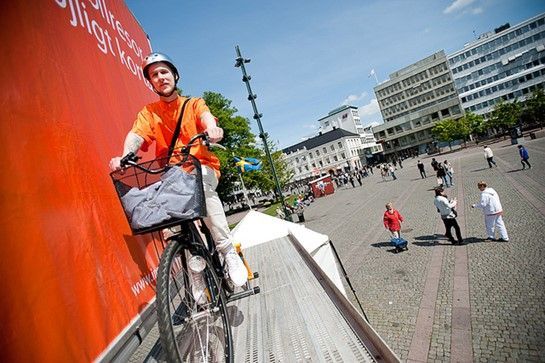
In 2018, the Spokane Transit Authority in Washington (USA) took a targeted approach with its “We’ve Got This” campaign, focussing on younger adults and university students. By emphasising public transit as a solution to common challenges, such as affordability, convenience, and availability, through everyday language and relatable messaging, Spokane saw a 0.6% rise in ridership and a 15-point increase in social engagement. The campaign also led to a 20% year-over-year increase in ridership at Gonzaga University, showcasing how tailored, audience-centric communications can positively influence travel choices in a short time.
Photo source: Spokane Transit Authority
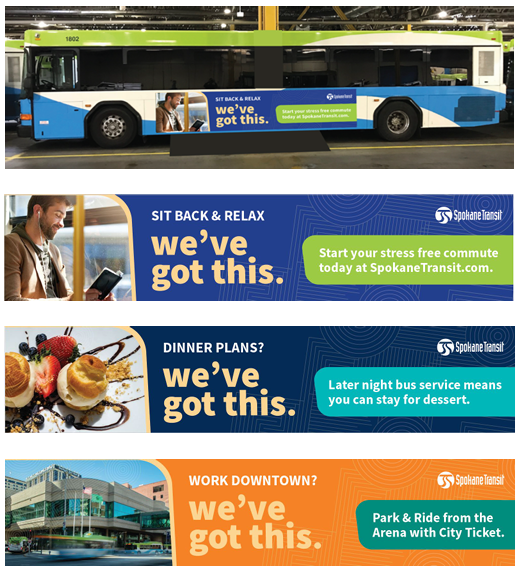
In the UK, Nexus's “Buses Are Getting Better” 2010 campaign in Tyne and Wear focussed on communicating convenience and service improvements through testimonials from real passengers. This campaign strategically used direct leaflets and bus shelter ads to target 10,000 households, leading to a 5% increase in bus use. Clear, relatable messaging from trusted community voices helped normalise bus travel, underscoring the power of localised and accessible communication.
Lastly, Toulouse, France, ran a citywide carpooling campaign to promote shared commutes. Through activities like a dedicated “carpooling week,” personalised travel planning, and competitions, the campaign achieved an 18% increase in carpooling through 2015 – 2016. This initiative demonstrated how an integrated communications strategy, backed by practical tools and incentives, can increase sustainable commuting options and reduce single-occupancy trips.
Picture source: EU Urban Mobility Observatory

Key takeaways for organisations to maximise campaign impacts
Drawing on insights from these successful campaigns, In the Round’s STRIVE consultancy service is here to support organisations in developing impactful, behaviour-changing initiatives for spectator travel. Here are some key strategic takeaways:
1.
Understand audience needs and tailor messaging
Campaigns like the Gold Coast 2018 Commonwealth Games and Spokane’s campaign demonstrate the importance of understanding the unique needs and preferences of different audience groups. By leveraging data insights, campaigns can craft targeted messages that resonate with specific segments, such as those based on their travel habits or proximity to services. For instance, sending bus updates to individuals near bus corridors or rail station info to those close to train lines. Geo-targeting can enhance this approach by providing real-time, location-based updates, ensuring the information is both relevant and timely. These personalised strategies underscore the benefits of sustainable travel, such as time savings or cost reductions, driving higher engagement and fostering positive behaviour change.
2. Develop a compelling narrative
As seen in campaigns like Malmö’s "No Ridiculous Car Journeys," creating a compelling and relatable narrative that sparks conversation can drive significant behavioural shifts. The bold, thought-provoking approach of this campaign reduced short car trips significantly, demonstrating how strong storytelling can engage audiences and inspire change.
3. Ensure collaboration and alignment across stakeholders
The success of the Eisteddfod Festival’s sustainable travel plan was built on strong collaboration between local agencies, event organisers, transport providers, and businesses. Involving all relevant stakeholders and ensuring aligned goals are critical to ensuring a unified message and effective delivery of sustainable travel initiatives.
4. Multi-channel outreach and engaging activations
Campaigns such as those for the Champions League Final, Glasgow Commonwealth Games and Nexus’s “Buses Are Getting Better” utilised a range of communication channels to maximise their reach. Multi-channel strategies, combining digital, outdoor, and direct engagement, are key to raising awareness and ensuring consistent messaging across all platforms.
5. Schedule and plan campaign activities carefully
Timing and planning are crucial to the success of campaigns. The London 2012 Olympics demonstrated the impact of a well-coordinated, timely approach, ensuring that campaigns were active in the lead-up to the event. Similarly, the Gold Coast campaign’s high recall rates were a result of well-timed interventions and promotional efforts in key locations.
6. Measure, monitor, and adapt for success
A continuous focus on measuring the effectiveness of campaigns is essential for their success. The results from the Glasgow Commonwealth Games and Toulouse’s carpooling initiative show how tracking campaign impact and adapting strategies for better results can lead to sustained behaviour change and improved transport system outcomes.
Conclusion
Effective marketing and communication are as critical to a successful transport strategy as the infrastructure itself. STRIVE consultancy service brought to you by In the Round brings proven experience and tailored solutions to help organisations engage audiences, reduce congestion, and support sustainable travel. Through understanding, collaboration, compelling narratives, and multi-channel strategies, we ensure campaigns are both impactful and adaptable to deliver measurable success in encouraging sustainable spectator travel. Whether it’s through careful planning or ongoing adaptation, we provide the expertise needed to drive positive, lasting change.

